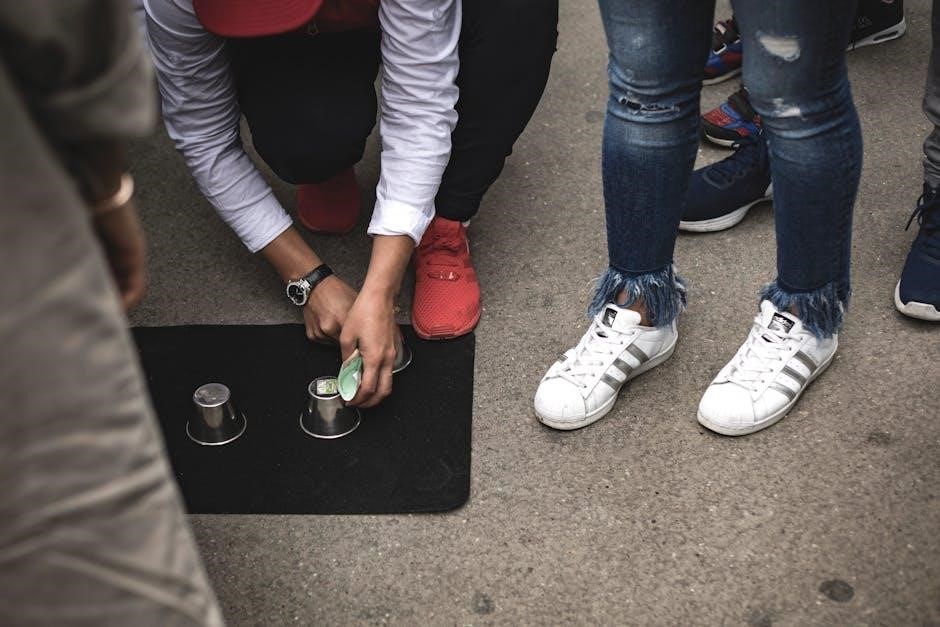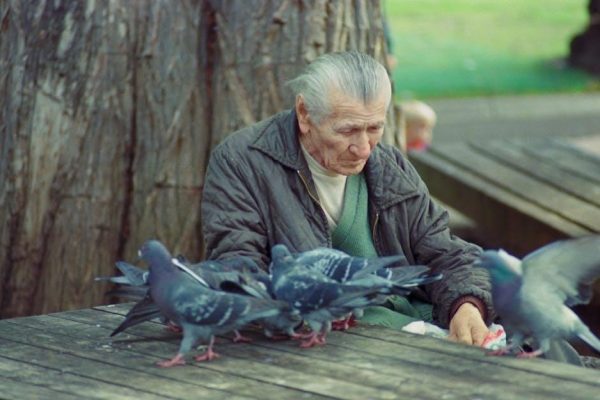This guide introduces the essential instructions for trick-or-treaters, focusing on the crossword clue “Instruction to trick-or-treaters” with the answer ONEEACH, ensuring a safe and enjoyable Halloween experience.
Definition and Purpose of Trick-or-Treating
Trick-or-treating is a beloved Halloween tradition where children dressed in costumes visit neighbors to ask for treats, typically candy or small toys. The phrase “Trick or Treat” serves as a polite request, with the understanding that trick-or-treaters will receive a treat in exchange for their visit. The purpose of this activity is to foster community engagement, celebrate the festive spirit, and allow children to enjoy a fun and safe experience. It also teaches important social skills, such as etiquette and gratitude. The crossword clue “Instruction to trick-or-treaters” highlights the idea of fairness, with the answer ONEEACH, emphasizing the practice of taking one piece of candy per person. This tradition remains a cornerstone of Halloween celebrations worldwide.

Historical Background of Halloween Traditions
Halloween has its roots in the ancient Celtic festival of Samhain, marking the end of the harvest season and the beginning of winter. The Celts believed that on October 31st, the boundary between the living and the dead blurred, and spirits of the deceased returned. To ward off these spirits, people wore costumes and lit bonfires. Over time, as Christianity spread, the festival evolved into All Hallows’ Eve, later known as Halloween. The tradition of trick-or-treating emerged from the medieval practice of “souling,” where poor individuals would receive food in exchange for praying for the dead. This practice was brought to North America by European settlers and eventually transformed into the modern activity we know today, emphasizing fun, community, and treats for children.
Modern-Day Significance of Trick-or-Treating
Trick-or-treating has become a cornerstone of modern Halloween celebrations, emphasizing community bonding and child development. It allows children to engage in imaginative play, practice social skills like greeting neighbors, and experience the thrill of collecting treats. The activity also fosters a sense of belonging and connection within neighborhoods. Parents often view it as an opportunity to teach etiquette and safety awareness. Additionally, trick-or-treating has become a platform for promoting inclusivity, with many households offering allergen-free options to accommodate children with dietary restrictions. The tradition continues to evolve, blending cultural heritage with contemporary values, making it a cherished event for families worldwide.

Understanding the Crossword Clue: Instruction to Trick-or-Treaters
The crossword clue “Instruction to trick-or-treaters” refers to the phrase ONEEACH, indicating one piece of candy per person, ensuring fairness and moderation in Halloween treat collection.
Overview of the Crossword Puzzle Context
The crossword puzzle context for the clue “Instruction to trick-or-treaters” is found in The New York Times Crossword, specifically on March 31, 2024. This clue belongs to the quick crossword section, designed for solvers seeking a challenge without excessive complexity. Crossword puzzles like this are popular for their ability to stimulate mental acuity and provide entertainment. The clue itself is straightforward, focusing on a common Halloween practice, making it accessible to a wide audience. Such puzzles often include seasonal themes, and Halloween-related clues are particularly favored during October. The answer, ONEEACH, fits neatly into the grid, adhering to the standard rules of crossword design; This type of clue encourages participants to think creatively while remaining grounded in familiar traditions. Overall, the crossword serves as a delightful mental exercise, blending fun with cognitive engagement;
Explanation of the Clue “Instruction to Trick-or-Treaters”
The clue “Instruction to trick-or-treaters” from The New York Times Crossword puzzle hints at a common directive given to children during Halloween. The answer, ONEEACH, refers to the practice of taking one piece of candy from each bowl offered by homeowners. This instruction is often provided by parents to ensure children do not overindulge or appear greedy. The clue cleverly ties into the traditional Halloween activity, making it relatable and solvable for participants familiar with the custom. By focusing on this specific behavior, the crossword highlights a key aspect of trick-or-treating etiquette, emphasizing moderation and respect for others’ offerings. This clue exemplifies how crosswords often blend cultural knowledge with wordplay to create engaging puzzles.
Revealing the Answer: ONEEACH
The crossword clue “Instruction to trick-or-treaters” is solved by the seven-letter answer ONEEACH. This phrase reflects the common guideline for children to take only one piece of candy from each house they visit. The answer aligns with the etiquette of trick-or-treating, emphasizing moderation and respect for others’ offerings. ONEEACH highlights the balance between enjoying the holiday and avoiding excessive behavior; It also underscores the importance of teaching children about boundaries and politeness during Halloween activities. This solution, featured in The New York Times Crossword on March 31, 2024, is both culturally relevant and thoughtfully crafted, making it a fitting answer for the clue.

Basic Rules for Trick-or-Treaters
Trick-or-treaters should say “Trick or Treat” and “Thank You,” respect homes, stay visible, and only take ONEEACH piece of candy from each house, ensuring a polite and safe experience.
Etiquette: Saying “Trick or Treat” and “Thank You”
Saying “Trick or Treat” and “Thank You” are fundamental to trick-or-treating etiquette. These phrases show respect and gratitude to homeowners who provide treats. When ringing a doorbell, children should clearly say “Trick or Treat” in a polite tone, making eye contact if possible. After receiving candy, a sincere “Thank You” is essential to acknowledge the homeowner’s kindness. These simple courtesies foster a positive experience for both trick-or-treaters and those giving out treats. Good manners, such as speaking loudly enough to be heard but not overly loud, are also important. Parents should encourage their children to practice these phrases beforehand to ensure they are delivered confidently and respectfully. This etiquette not only makes the interaction enjoyable but also upholds the spirit of Halloween traditions.
Respecting Neighborhood Guidelines
Respecting neighborhood guidelines is crucial for a harmonious trick-or-treating experience. Many communities establish specific hours for trick-or-treating, often between early evening and 9 p.m., with younger children typically out around sunset. Trick-or-treaters should adhere to these times to avoid disturbing residents. Additionally, it’s important to respect “No Trick-or-Treaters” signs on doors or lawns, as some homeowners may choose not to participate. Avoid cutting across lawns or damaging property, and stay on designated pathways. Loud noises should be kept to a minimum, especially in residential areas. By following these guidelines, trick-or-treaters can ensure a positive experience for both themselves and the community. Respectful behavior fosters goodwill and maintains the spirit of Halloween traditions.
Understanding Age Limits and Parental Involvement
Trick-or-treating typically has no strict age limits, but most children stop participating between ages 12 and 16. Parents should use discretion, as some teens enjoy the tradition while others outgrow it. For younger children, parental involvement is essential to ensure safety and etiquette. Accompanying kids during trick-or-treating helps them navigate neighborhoods and teaches them to say “Trick or Treat” and “Thank You.” Parents should also discuss boundaries, such as staying within designated areas and avoiding unsafe houses. As children grow older, parents can gradually reduce their involvement, encouraging independence while ensuring they understand the importance of respecting homeowners and following community rules. This balance helps create a fun and responsible Halloween experience for all ages.

Safety Tips for Trick-or-Treaters
Ensure visibility with flashlights or glow sticks, and stay alert while crossing streets. Carry lights to be seen by drivers and avoid dark pathways for added security.
Importance of Visibility and Lighting
Visibility is crucial for trick-or-treaters, especially at dusk or night. Wearing reflective costumes and carrying flashlights or glow sticks ensures they can be seen by drivers. Proper lighting helps navigate dark sidewalks and driveways, reducing trip hazards. Glow necklaces or LED accessories enhance visibility, making it easier for motorists to spot children. Additionally, well-lit costumes aid in staying visible to fellow trick-or-treaters, fostering a safer and more enjoyable experience. Parents should encourage the use of bright colors and lights to minimize risks associated with low visibility. This simple precaution significantly contributes to a safe Halloween outing.
Carrying Flashlights or Glow Sticks
Carrying flashlights or glow sticks is a vital safety measure for trick-or-treaters. These tools provide light in dark neighborhoods, helping children see and be seen. Flashlights illuminate paths, reducing tripping hazards, while glow sticks offer a hands-free alternative. Both options enhance visibility to drivers, making it safer to cross streets. They also help children spot obstacles and navigate unfamiliar areas. Additionally, glow necklaces or bracelets can complement these items, ensuring trick-or-treaters remain visible throughout their route. Parents should ensure each child carries a reliable light source, fostering a safer and more enjoyable Halloween experience. This simple precaution is essential for navigating the evening effectively and responsibly.
Ensuring Safety While Crossing Streets
Ensuring safety while crossing streets is crucial for trick-or-treaters. Children should always use crosswalks and follow traffic signals. Holding an adult’s hand can prevent accidents, especially for younger kids. Before crossing, they should stop, look both ways, and listen for oncoming vehicles. Reflective costumes or accessories increase visibility to drivers. Avoiding distractions like using phones while crossing is important. Teaching children to make eye contact with drivers before stepping into the road adds an extra layer of safety. Parents should accompany children, especially at night, to guide them safely. These precautions help minimize risks and ensure a secure trick-or-treating experience. Staying vigilant and following these rules can prevent accidents and allow everyone to enjoy Halloween without incidents.

Trick-or-Treating Etiquette
Trick-or-treating etiquette involves greeting homeowners politely, expressing gratitude, and respecting their property. Avoiding damage and considering others’ allergies ensures a positive experience for everyone involved.
Being Polite and Respectful to Homeowners
Being polite and respectful to homeowners is crucial during trick-or-treating. Greet them with a cheerful “Trick or treat!” and don’t forget to say “Thank you” after receiving candy. This simple courtesy makes the experience enjoyable for everyone. Avoid ringing the doorbell excessively or lingering too long. If a homeowner declines to give candy, gracefully move on. Respect their property by not damaging gardens or knocking over decorations. Remember, homeowners are contributing to the festive spirit, so showing appreciation fosters a positive community atmosphere. Good manners reflect well on both the trick-or-treaters and their families, ensuring a welcoming environment for future celebrations.
Avoiding Damage to Property
Avoiding damage to property is a key aspect of trick-or-treating etiquette. Trick-or-treaters should never intentionally damage or vandalize homeowners’ property, such as gardens, mailboxes, or decorations. Respectful behavior ensures that the tradition remains enjoyable for everyone. Refraining from actions like knocking over plants or leaving trash behind helps maintain a positive relationship between trick-or-treaters and the community. Parents should remind children to stay on designated paths and avoid touching or damaging any belongings. By taking care to preserve the neighborhood’s appearance, trick-or-treaters contribute to a safe and welcoming environment. This mindfulness fosters goodwill and ensures that Halloween remains a cherished annual event for all participants. Always remember, respect for others’ property is essential.
Considering Allergies and Dietary Restrictions
Considering allergies and dietary restrictions is crucial for trick-or-treaters and homeowners alike. Many children have severe food allergies, such as peanuts or dairy, which can make certain candies harmful. Homeowners are encouraged to offer allergen-free treats or non-food items to accommodate these needs. Trick-or-treaters should carry a container that allows for easy sorting of candies to avoid cross-contamination. Parents should also educate their children on the importance of checking candy labels for allergens before consumption. By being mindful of these considerations, everyone can enjoy a safe and inclusive Halloween experience. This thoughtful approach ensures that no child feels left out and promotes a considerate community environment. Always prioritize health and safety to make the holiday enjoyable for all participants.

Community and Neighborhood Guidelines
Trick-or-treating typically occurs between 6 p.m. and 9 p.m., with younger children starting earlier. Check local guidelines for exact hours. Participating homes often display porch lights or signs to indicate welcome. Respect neighborhoods by staying on sidewalks and avoiding non-participating houses. This ensures a harmonious and enjoyable experience for both trick-or-treaters and residents. Always follow community rules to maintain a positive atmosphere. Safety and courtesy are key to a successful Halloween outing. Be mindful of noise levels and property boundaries to foster goodwill within the community. This approach promotes a respectful and joyful celebration for everyone involved. Adhering to these guidelines helps create lasting memories while preserving neighborhood harmony. Remember, kindness and consideration go a long way in building strong community ties. By following these simple rules, trick-or-treaters can enjoy a fun and safe experience. Happy Halloween! Community guidelines ensure that the tradition remains enjoyable for all participants.
Typical Hours for Trick-or-Treating
Trick-or-treating hours vary by community but generally occur between 6 p.m. and 9 p.m. Younger children often start earlier, around sunset (approximately 6 p.m.), while older kids may continue until 9 p.m. Some neighborhoods specify earlier end times to accommodate younger participants. It’s essential to check local guidelines or news outlets for exact hours, as they can differ by area. Many communities also designate specific start and end times to ensure safety and organization. Visibility is crucial during these hours, so carrying flashlights or wearing glow-in-the-dark accessories is recommended. Staying within these time frames helps ensure a smooth and enjoyable experience for both trick-or-treaters and homeowners. Always respect local rules to maintain a positive and safe environment for everyone involved; Happy Halloween!

Identifying Participating Houses
To identify houses participating in trick-or-treating, look for decorations like jack-o’-lanterns, Halloween lights, or spooky themes. Porch lights often signal participation. Some neighborhoods use signs or stickers to indicate involvement. If unsure, check local community resources or ask neighbors for insights. Respect houses without lights or decorations, as they may not be participating. This approach ensures a fun and respectful experience for everyone involved.
Respecting Houses That Do Not Participate
Respecting houses that do not participate in trick-or-treating is crucial for maintaining a positive community experience. If a house has its porch light off or no Halloween decorations, it’s a clear sign they are not participating. Avoid knocking on doors of houses that appear uninterested or unwelcoming. Never assume they will give treats if they’ve chosen not to participate. Instead, politely move on to the next house without causing disturbance. Respect their decision, as not everyone may wish to engage in the tradition. By doing so, you ensure a respectful and enjoyable experience for both trick-or-treaters and homeowners alike. Always prioritize kindness and understanding in such situations.

Preparing for Trick-or-Treating
Preparing for trick-or-treating involves choosing a safe costume, carrying a candy container, and planning a route in advance to ensure an efficient and enjoyable experience.
Choosing the Right Costume
Selecting the perfect costume is a crucial part of trick-or-treating preparation. It should be safe, comfortable, and reflective of the Halloween spirit. Opt for materials that allow visibility and ease of movement. Avoid oversized shoes or accessories that could cause tripping. Consider weather conditions and layer clothing if necessary. Ensure the costume is allergy-friendly and doesn’t include potential allergens. Choose a design that aligns with cultural sensitivity to avoid offending others. Bright colors or reflective elements can enhance visibility, reducing accidents. Parents should guide children in selecting costumes that balance creativity with practicality; The right outfit ensures a fun and safe trick-or-treating experience for all participants. Costume choices set the tone for an enjoyable and memorable Halloween night.
Bringing a Candy Container
A sturdy and size-appropriate candy container is essential for trick-or-treaters. Choose a bucket, bag, or pumpkin-shaped holder that is easy to carry and has a secure closure. Ensure it’s large enough to hold plenty of treats but not so heavy when full. Opt for containers with reflective or glow-in-the-dark features to enhance visibility at night. Avoid flimsy materials that might tear easily. Parents should consider eco-friendly options or reusable bags to promote sustainability. The container should also have enough space for other items like a flashlight or map. A well-chosen candy holder ensures treats stay organized and secure throughout the night, making the trick-or-treating experience more enjoyable and stress-free for both kids and parents. It’s a practical yet festive way to collect Halloween goodies.
Planning the Route in Advance
Planning the trick-or-treat route in advance ensures a smooth and efficient Halloween experience. Identify neighborhoods with participating houses, often marked by porch lights or decorations. Map out a logical path to minimize walking distances and avoid unnecessary backtracking. Consider starting in areas with lower traffic and progressing to busier spots. Parents should review the route with children, ensuring they know the plan and can navigate safely. Include breaks for rest or hydration if needed. Prioritize houses known for generous treats or allergy-friendly options. End the route near a familiar landmark to ensure everyone returns home safely. A well-planned route enhances the fun, reduces stress, and ensures all trick-or-treaters enjoy the evening without missed opportunities or conflicts.

Additional Tips for a Successful Experience
Stay in groups for safety, check candy before consumption, and be mindful of the environment. These tips ensure a fun, safe, and responsible trick-or-treating experience for everyone.
Staying in Groups for Safety
Trick-or-treating in groups enhances safety, especially for children. Adults should accompany younger kids, while tweens and teens can stay together, ensuring everyone looks out for each other. Staying in groups reduces the risk of accidents, gets help quickly if needed, and makes the experience more enjoyable. Flashlights or glow sticks can help groups stay visible to drivers and each other, ensuring a fun and secure Halloween night.
Checking Candy Before Consumption
Before enjoying Halloween treats, it’s crucial to inspect all candy. Parents should check for opened, tampered, or expired items, ensuring everything is safe. Teach children to only eat candy that’s sealed and from trusted sources, avoiding homemade or suspicious treats. This precaution helps prevent potential health risks and ensures a safe trick-or-treating experience for everyone.
Being Mindful of the Environment
Trick-or-treaters should be mindful of their environmental impact during Halloween. Using reusable candy bags or containers reduces waste, while avoiding single-use plastics helps protect the planet. Costumes and accessories should be chosen with sustainability in mind, opting for second-hand or eco-friendly options. Additionally, families can participate in community initiatives that promote recycling or donating unused candy. By being environmentally conscious, trick-or-treaters can enjoy the holiday responsibly, ensuring a greener future for generations to come. This mindful approach not only benefits the planet but also sets a positive example for others to follow during festive celebrations.
The crossword clue “Instruction to trick-or-treaters” highlights the tradition’s essence, emphasizing respect, safety, and fun. Halloween remains a cherished event, blending community spirit with timeless joy, making it an unforgettable experience for all participants.
Final Thoughts on Trick-or-Treating Etiquette
Trick-or-treating etiquette is all about gratitude and respect. Saying “Trick or Treat” and “Thank you” shows appreciation for the treats received. Respecting homeowners’ boundaries is crucial, especially for those who may not participate. Understanding age limits and ensuring younger children are accompanied by adults helps maintain a safe and enjoyable experience. Being polite and avoiding damage to property fosters a positive community environment. Additionally, considering allergies and dietary restrictions when offering or accepting treats promotes inclusivity. By following these guidelines, trick-or-treaters contribute to a fun and respectful Halloween tradition for everyone involved. Remember, etiquette is key to creating lasting memories and a welcoming atmosphere in neighborhoods.
Encouraging a Positive Community Experience
A positive community experience during Halloween is fostered through mutual respect and inclusivity. Homeowners can create a welcoming environment by offering a variety of treats, including allergen-free options, to accommodate all trick-or-treaters. Trick-or-treaters should express gratitude and respect boundaries, ensuring a pleasant interaction for everyone. Neighborhoods often set specific hours for trick-or-treating, promoting safety and organization. By engaging in these practices, communities strengthen bonds and create cherished memories. A positive experience benefits both participants and residents, making Halloween a celebration of togetherness and joy. This collective effort ensures that the tradition remains a highlight of the year for all involved.
Wrapping Up the Halloween Tradition
Halloween concludes with the delightful tradition of trick-or-treating, a cherished activity for many. Safety remains a top priority, with visibility and cautious street crossings ensuring a secure experience. Respect for homeowners and their property is key, fostering a positive atmosphere. The crossword clue “ONEEACH” serves as a reminder to take one treat per house, promoting fairness. As the night winds down, children often sort their candy, relishing the fruits of their adventure. This tradition strengthens community bonds, creating lasting memories. Halloween’s legacy endures as a time for joy, connection, and celebration, leaving everyone eagerly anticipating next year’s festivities.





